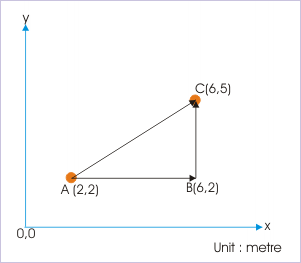| << Chapter < Page | Chapter >> Page > |
Thus, displacement is equal to the difference between final and initial position vectors. It is important to note that we obtain the difference between final and initial position vectors by drawing a third vector starting from the tip of the initial position vector and ending at the tip of the final position vector. This approach helps us to quickly draw the vector representing the difference of vectors and is a helpful procedural technique that can be used without any ambiguity. Equivalently, we can express displacement vector in terms of components of position vectors as :
We must emphasize here that position vectors and displacement vector are different vectors quantities. We need to investigate the relation between position vectors and displacement vector - a bit more closely. It is very important to mentally note that the difference of position vectors i.e. displacement,Δ r , has different directional property to that of the position vectors themselves ( and ).
In the figure above, the position vectors and are directed along OA and OB respectively, while displacement vector, Δ r , is directed along AB. This means that the direction of displacement vector need not be same as that of either of the position vectors. Now, what would be the situation, when the motion begins from origin O instead of A? In that case, initial position vector is zero (null vector). Now, let the final position vector be denoted as r . Then
and displacement is :
This is a special case, when final position vector itself is equal to the displacement. For this reason, when motion is studied from the origin of reference or origin of reference is chosen to coincide with initial position, then displacement and final position vectors are same and denoted by the symbol, " r ".
In general, however, it is the difference between final and initial position vectors, which is equal to the displacement and we refer displacement in terms of change in position vector and use the symbol Δ r to represent displacement.
Magnitude of displacement is equal to the absolute value of the displacement vector. In physical sense, the magnitude of displacement is equal to the linear distance between initial and final positions along the straight line joining two positions i.e. the shortest distance between initial and final positions. This value may or may not be equal to the distance along the actual path of motion. In other words, magnitude of displacement represents the minimum value of distance between any two positions.
Question : Consider a person walking from point A to B to C as shown in the figure. Find distance, displacement and magnitude of displacement.

Characteristics of motion : Two dimensional
Solution : The distance covered, s, during the motion from A to C is to the sum of the lengths AB and BC.
Displacement, AC , is given as :
The displacement vector makes an angle with the x – axis given by :
and the magnitude of the displacement is :

Notification Switch
Would you like to follow the 'Physics for k-12' conversation and receive update notifications?